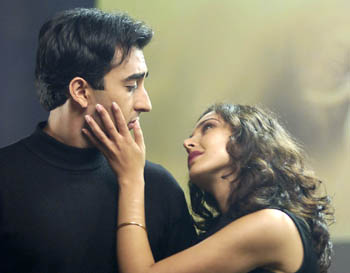![[Metroactive Movies]](/movies/gifs/movies468.gif)
[ Movies Index | Show Times | Silicon Valley | Metroactive Home | Archives ]

Dance Fever: Rahul Khanna and Lisa Ray tango in 'Bollywood/Hollywood.' Two 'Woods Don't Make a Right 'Bollywood/Hollywood' appropriates the least interesting parts of Indian cinema for Western consumption GLOMMING onto other people's culture is the American way, so congratulating the rising public interest in Bollywood films may be undue. Bollywood stands for Bombay Hollywood, meaning the Indian movie industry, which outproduces any other in the world, currently at a rate of about 1,000 films a year. Traces of Bollywood have spiced American movies, such as the finale of Moulin Rouge! or the beginning of Ghost World. At the art houses, we've seen releases of much-vaunted Bollywood epics, most notably Lagaan, which I found paralyzing, like being stuck at a real-time cricket match ("baseball on Valium,' as Robin Williams once quipped). The endless contest alternated with halftime breaks of particularly obvious messages of brotherhood: touch an untouchable today. Count me as one of Bollywood cinema's most fair-weather friends, possibly from having had to explain who Satyajit Ray was one too many times. No, Ray is not Bollywood, though the director's work speaks for itself, as can be seen during a retrospective at Palo Alto's Stanford Theater, beginning next week. Who can objection to joyous, colorful films for relaxation for a hard-working people? It's just that the Western celebration of the commercial qualities of Bollywood helps ensure that Indian cinema is going to remain at its most common: gaudy, tinsel, inoffensive merch. By not being more demanding, by not insisting that Indian movies be about something, we're patronizing a nation. As a line in the new film Bollywood/Hollywood has it: "Hollywood, Bollywood, two different woods, but they're both from the same tree." And that tree needs a good pruning. Bollywood/Hollywood, written and directed by Deepa Mehta (who did the much superior Fire), pays tribute to the genre, complete with the coy leading lady, the all-wise granny and the "prince in love with a commoner" premise. The apropos-of-nothing musical numbers are captioned here like music videos. Mehta does update the old-fashioned setting to a story of Toronto's substantial Indian community. A young and rich urban professional named Rahul (Rahul Khanna, kind of like George Lazenby) is ready to marry a white girl, Jessica Paré (from Denys Arcand's failed satire Stardom), who is supposed to be the Britney Spears of Canada; she's a pop star superficially taken by Indian mysticism and dies the death of a dabbler in spiritual matters. After she's dropped (literally), Rahul is pressured to marry an Indian girl by his mummy-ji (Moushumi Chatterjee). To use the lever used in Taming of the Shrew, the mother says that Rahul's sister won't marry until he does. Rahul hires an escort of mysterious background to pose as his fiancee. She's named Sue Singh (Lisa Ray), an enigmatic girl who insists on no physical contact. Singh is an Indian supermodel, raised in the West; she has, it's claimed, a multitude of hits on her website. That doesn't add up to something you can't take your eyes off of onsceen. Ray has a combination of stunning body and stunning blandness, unseen in tandem since the heyday of Lynda "Wonder Woman" Carter. While the leads court and quarrel, the wedding of Rahul's sister approaches, and the two have to decide what, exactly, their relationship is. Subplottage abounds, about Govind (Arjun Lombardi-Singh), Rahul's brother, who learns to stand up for himself, as well as about the clown/chauffeur Rocky (Ranjit Chowdhry), whose homely transvestite clowning is lifted directly from Robert Preston's bits in Victor/Victoria. Inside jokes litter the film, with references to dozens of Bollywood movies and a cameo by Bollywood star Akshaye Khanna. One joke likens grandma-ji (Dina Pathak) to Zohra Sehgal--that wonderful old comedian who scowls her way through so many Indian films, useful whenever you need a baleful reaction to some nugget of Western decadence. (She appears in a similar film to Bollywood/Hollywood, mixing musical clichés with modern-day émigré lives in Canada, the 1991 film Masala.) Bollywood/Hollywood has one scene of a party on a condo balcony, and for a moment, the film looks natural. It's amusing to see that the white party guests have been directed to be the chorus on the balcony, with the roguish nods of the head, the wagging of the fingers in the traditional Bollywood musical style. Otherwise, Bollywood/Hollywood looks like what happens whenever sophisticated people try on folk art; there's a layer of mannerism, of self-celebration of the cleverness of having noticed what was going on. Mehta did this film instead of finishing a trilogy she'd started; the first, the very recommended Fire, inflamed Muslim fundamentalists, who kept her from completing her newest film in India. It's plain she's taking a well-deserved break and doing some fluff. Whatever her motives, the forced cuteness of Bollywood/Hollywood isn't doing anyone's culture a service.
Bollywood/Hollywood (PG-13; 105 min.), directed and written by Deepa Mehta, photographed by Douglas Koch and starring Rahul Khanna, Moushumi Chatterjee and Dina Pathak, opens Friday at Camera 3 in San Jose.
Send a letter to the editor about this story to letters@metronews.com. [ Silicon Valley | Metroactive Home | Archives ]
|
From the October 2-8, 2003 issue of Metro, Silicon Valley's Weekly Newspaper.
Copyright © Metro Publishing Inc. Metroactive is affiliated with the Boulevards Network.
For more information about the San Jose/Silicon Valley area, visit sanjose.com.